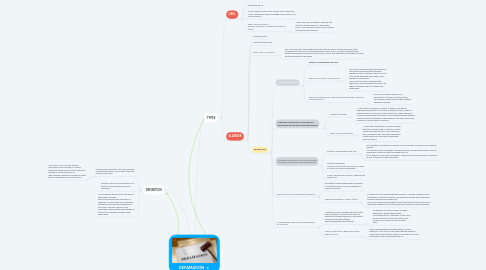
1. DEFINITION
1.1. Governed by Defamation Act 1950, however not expressly define. Can be define through common law cases.
1.1.1. Lord Atkin in Sim v Stretch defines defamation as a publication of untrue statement which tends to lower a person’s reputation in the estimation of right-thinking members of society or which tends to make them shun or avoid him.
1.2. Purpose of the tort of defamation is to protect a person’s good name and reputation.
1.3. Circumstances which one can be held for defamatory includes – actions/words/gestures may lead to a tendency to lower a person’s reputations depends on the facts and allegations in each case, and their impact on the reasonable, which means mere feelings of hurt can’t be awarded damages under defamation.
2. TYPES
2.1. LIBEL
2.1.1. Permanent form
2.1.2. Actionable per se
2.1.3. If found guilty as seen under section 499 of the Penal Code, a defendant may be punished under section 500 of the same act
2.1.4. Case: YOUSSOUPOFF V METRO-GOLDWYN-MAYER PICTURES LTD (1934)
2.1.4.1. In this case, the court had to consider the status of spoken words in a permanent form, in the context of a film. The court held that the film was libellous.
2.2. SLANDER
2.2.1. Temporary form
2.2.2. Not actionable per se
2.2.3. Case: LYNCH V KNIGHT
2.2.3.1. The court held that to make the words actionable by reason of special damage, that consequences must be such as taking human nature as it is, and having regard to the relationship between the parties concerned, it is fairly and reasonably anticipated to follow from the speaking of the words
2.2.4. EXCEPTIONS
2.2.4.1. SLANDER TO WOMEN
2.2.4.1.1. Section 4 of Defamation Act 1957
2.2.4.1.2. Case: LUK KAI LAM V SIM AI LENG
2.2.4.1.3. Case: MMI HAFILDA ALI v KETUA SETIAUSHA PARTI ISLAM SE MALAYSIA(PAS)
2.2.4.2. SLANDER IN RELATION TO A PERSON’S PROFESSIONAL OR BUSINESS REPUTATION
2.2.4.2.1. Section 5 provides:
2.2.4.2.2. Case: JOHN TAR CHONG
2.2.4.3. SLANDER IN RELATION TO TITLE, SLANDER OF GOODS AND MALICIOUS FALSEHOOD
2.2.4.3.1. Section 6 of Defamation Act 1957
2.2.4.3.2. Malicious Falsehood Malice or ill-will must be proved in a cause of action for Malicious falsehood
2.2.4.3.3. CASE; Ratus Mesra Sdn Bhd v Shaik Osman Majid & Ors
2.2.4.4. IMPUTATION OF A CONTAGIOUS DISEASE
2.2.4.4.1. A statement made alleging that the plaintiff is currently suffering from a contagious or infectious disease.
2.2.4.4.2. Case: BLOODWORTH V GRAY (1844)
2.2.4.5. IF THE WORDS IMPUTE THE COMMISSION OF A CRIME
2.2.4.5.1. A statement made alleging that the plaintiff has committed a crime for which he may have been punished severely or go through corporal punishments (death penalty/whipping/imprisonment).
2.2.4.5.2. Case: SIVNATHAN V ABDULLAH DATO ABD' RAHMAN

